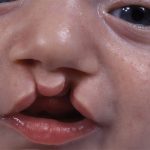 Most common craniofacial anomaly, occurring 1 in 600–700 live births, characterized by failure of fusion between embryologic processes during facial morphogenesis. Failure of fusion between the medial and lateral nasal and the maxillary processes results in a cleft of the lip and/or alveolar process, whereas failure of fusion between the lateral palatine processes results in a cleft of the palate. The cleft may be complete or incomplete, and it can occur unilaterally or bilaterally. Cleft lip may occur without clefting of the alveolar process or palate, and cleft palate can also occur as an isolated phenomenon.
Most common craniofacial anomaly, occurring 1 in 600–700 live births, characterized by failure of fusion between embryologic processes during facial morphogenesis. Failure of fusion between the medial and lateral nasal and the maxillary processes results in a cleft of the lip and/or alveolar process, whereas failure of fusion between the lateral palatine processes results in a cleft of the palate. The cleft may be complete or incomplete, and it can occur unilaterally or bilaterally. Cleft lip may occur without clefting of the alveolar process or palate, and cleft palate can also occur as an isolated phenomenon.
A congenital condition in which the upper lip fails to form in the usual way during fetal development.
An opening in the midline of the palate as the result of failure of the two sides to fuse during embryonic development.
A congenital condition in which the palate does not fuse during fetal development, causing a gap between the mouth and nasal cavity in severe cases.
Cleft lip and palate are congenital malformations affecting the jaw region. The most severe forms include dis-configuration of the lips, nose, upper jaw, teeth, and palate. These defects generally result from the palatal shelves failing to join together during the sixth to eight week of fetal development. The resulting opening, known as a cleft, may occur in the upper lip, alveolus, and palate (World Craniofacial Foundation, 1998).
Congenital defect in which there is a fissure in the midline of the palate, either partial or extending through both hard and soft palates and into the nasal cavities, often associated with cleft in the upper lip. A common birth defect (occurring in about 1 in 2,500 births and more frequently in females), it is treated by special feeding techniques, reconstructive surgery, care of any associated speech, hearing, and oral problems, and emotional support.
Unilateral or bilateral congenital deformity where the maxilla fails to completely close, resulting in an opening in the bone and skin.
